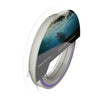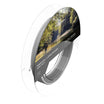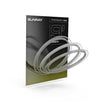It is often said that we fly fishers progress through several stages of development. You might have read this sort of thing before: it starts with the desire to catch a fish; then the desire to catch lots of fish; followed by the desire to catch a big fish; then lots of big fish.....and so on until a zen-like state is reached where we question if the trout we want to catch actually exists at all. A kind of Schrodinger's Trout.
When I trawl through my own angling journey to date, I suppose it does follow that pattern, albeit approximately (somewhere along the line I made the side step from wanting to catch lots of big stocked rainbow trout, to catching a wild brown trout, which threw things out of kilter for a while).
Looking back, by far the most difficult hurdle to overcome has been the catching of large, wild trout. The preceding stuff was fairly routinely navigated by a combination of enthusiasm, trial and error, some much needed guidance and lots of hours on the water. But somehow making the transition from just catching lots to being able to smoke out better fish with any consistency proved an altogether less tangible skill which it has taken years to gain any proficiency at all in.....and believe me there's an awful long way to go yet! Below is what I have learned so far. Some has come from hard earned experience, some from books and the advice of more experienced anglers, yet more from just observing top practitioners at work. The consistent capture of large wild trout often involves a little luck, but underpinning everything is sheer persistence and adherence to a set of basic principles which if followed, can help to put the odds firmly in your favour. In no particular order.......
Fish in places known to hold big trout.
This might sound obvious, but it's amazing how often details like this are neglected. Besides, what exactly constitutes a big trout? In my book a fish over 2lb breaches the threshold into big trout territory and anything substantially bigger gets the scales under it for an accurate weight. For sure there are venues where a trout that size doesn't raise so much as an eyebrow, but I would argue that in a general UK context where Salmo trutta is typically a fish of sub twelve inches, a two pounder is a good 'un.

A fine fish of 2lb 10oz from the River Ribble
One of the most reassuring pieces of advice I ever received was 'you can only catch what's in front of you'. If your chosen venue holds a good head of large trout, you will get a shot at them over time, whereas you cannot magic fish out of thin air if they are just not present in the first place. Most rivers hold an odd lunker in their deepest, darkest corners, and every so often these incongruously large beasts are caught by bait anglers, spinners, or flyfishers prepared to pull streamers back through the likely lies. But it's all relative and if your river's usual stamp of fish is in the 6-8" class you cannot reasonably expect to catch much larger fish regularly. Go and look elsewhere.
You might expect the haunts of exceptional trout to be kept closely guarded secrets and there is an element of truth in this; but on the other hand, rivers and stillwaters with a reputation for producing larger than average fish are often quite widely known and publicised in the angling press and via social media. The rest boils down to how much effort you are prepared to make to get there and put the fishing time in. As a trout-nut friend of mine says 'what price do you put on trophy trout?' and the degree to which we will nod in agreement with that rhetoric will depend upon the degree to which obsession has taken hold of our lives. I was forced to confront that question earlier this year when a friend and I made considerable expenditure of time, money and effort to fish some large Scottish lochs in search of that rarest of commodities - a ferox trout prepared to take a fly. Given our chances were fairly slim you might question our sanity, but after three days of hard graft and concentration we came away with not only dozens of loch 'bandies', but two ferox with a combined weight of 27lb 2oz. We had each caught a fish of a lifetime and suddenly the sacrifices felt like nothing at all.
Fish the dry fly
In the context of running water, I am now fully convinced that the dry fly gives us the best chance of consistently contacting the bigger fish in the river. Back in the nineties I recall reading a piece by Mike Weaver in which the author asserted that over the course of a season, the dry fly would sort out the bigger fish more consistently than any other method. I had my doubts, thought I knew better. I hadn't long since made a tentative step into river trouting and my stillwater experience bank still told me that large lures and wet flies offered the best chance of contacting a lump. Besides, we all know that 90% of fish feeding is done sub-surface and so percentages chance would have nymphs and streamers as the tactic of choice right?
Well nearly twenty years down the line I realise the error of my naivety, although to be fair it's an easy mistake to make. I'm not saying the sub surface flies don't nail the odd biggie - far from it, pulling streamers in particular can account for some of the very largest fish - but we're searching for consistency here, and if you want to keep amongst the top end fish your river holds, then dry fly is the way to go. Here's why:
It's a matter of location, pure and simple. Once we spot a rising trout we have accomplished two vital pieces of the jigsaw - we've found a fish and it's eating. It may be small, middling or large, but at least the 'needle in a haystack' bit has been eliminated. Proceed along these lines and sooner or later you will chance upon the beast you were looking for....and I'll bet it won't take half as long as just blindly fishing the water.
I look at it like this: if you fish a search method (nymph, duo, wet flies, streamers etc) through a stretch of river, provided the method is deployed half competently it will pull a few fish, maybe a lot of fish. All the while you are getting regular action it feels like the next fish could easily be a biggie - only a matter of time, percentages, whatever. But let's consider a hypothetical scenario where all fish in the stretch are removed, save for the top 5% size class. How many fish does that leave? A fisheries scientist might be able to answer that, but I'm going to make a guess - let's say for argument's sake we are talking two dozen fish per mile. So we come to a nice big pool of 100yds long and all it contains is a pair of trout. How confident would you be of stumbling upon one of those fish on nymphs now, especially when considering that they might only spend a short period of time each day or two actively on the feed and the rest of the time holed up under boulders or bankside tree roots? Of course, come to the same pool and find one or both on the fin and rising to a hatch of fly and it's suddenly game on and the balance has just been tipped massively in your favour. The artificial might still have to be landed exactly within a four inches wide feed lane, but at least we can see where we need to put it!
So concentrate your efforts on finding rising fish. It's not just for purists, it's the single most reliable way of catching trophy trout. As such, the following paragraphs assume we will be mainly targeting rising fish.

Master dry fly fisherman Paul Procter returns a good river trout
Wild creatures = stealth required!
Surprisingly, this is often completely overlooked by anglers. A friend who spends his life stalking large trout, crouched in the undergrowth and kneeling amongst the stones, despairs when a fellow angler comes ambling along the top of the bank. cheerfully enquiring if any fish have been caught. Adopt this approach and a big wild trout will be gone before you even knew it was there. A good analogy is that of stalking deer; you can't just stroll up to within shooting range and expect the beasts to stand there looking at you while you raise the gun to your shoulder. Every movement, vibration, noise and scent has the potential to spook a wild creature into flight be it a deer, bird, rabbit or any other game; and fish are no different . Well maybe they are a little different in the sense that their aquatic environments separates us and affords a degree of cover in itself when approaching. I mean you couldn't crouch waving a rod in the air a few yards behind a rabbit and expect it to stay put......but the principles remain. The less aware of your presence a big trout is, the more likely it will eat your fly!
The good news is, given an appropriate degree of stealth, it is often possible to get remarkably close to rising trout, particularly when they are feeding - as they so often do - in shallow water and the necessarily shallow field of vision that affords. This at least gives us a chance of a decent presentation and maybe repeated shots at the fish if we don't quite get it right first time - far better than a long, hopeful chuck which ends in a badly dragging fly, knackering our chances right away. So low and slow is the way to go - invest the time, study the fishes' rise rhythm and behaviour, and formulate your plan as you approach. The rest is the easy bit.

Keeping a low profile when stalking trout is of utmost importance.
The power of observation.
Central to everything is the willingness to observe. Not just a casual look here and there, but proper close and sustained observation. The best anglers I know are all hugely inquisitive and spend an awful lot of time not fishing, but creeping around, just watching and waiting and all the time learning more about the ways and behaviour of their quarry. Oftentimes the larger trout adopt feeding lies some way distant to their resting lies, in what at first glance might appear unlikely spots. You may have experienced this phenomenon when casting over a blipping rise in inches of water, assuming a skerrit will result.....only for a lump of a fish to explode in a flurry of spray when the connection is made.
Long term observations of where the better trout choose to feed in various water heights can only pay dividends - another tip of the balance in your favour when you start to instinctively know where and when to intercept them at certain times. An example which springs to mind is a pool I know on the River Eden. It is a dark, treelined, slow flowing pool with a bed of carved sandstone in its lower half and then up around a left hand bend, a more typical seamy head over shallow cobbles interspersed with small boulders. It usually holds some fine fish and until a couple of years ago I always believed that those fish were most likely to be found in the main body of the pool, within close bolting distance of the bedrock slots they undoubtedly called sanctuary. Quite often I would come to that pool and find nothing happening at all, but just every so often there would be a couple of fish on the go mid stream, and a suitably quiet approach could result in a memorable trout.
Then on the edge of darkness one evening in midsummer 2013 I found myself in the skinny water around the corner at the head of the pool, casting to tiny rises tight to the far bank grasses and in about eight inches of water The going had been slow and with night approaching I needed a fish or two no matter how small, just to say I hadn't blanked. You can guess what's coming - I rose, hooked and landed one of the 'tiny risers'. It weighed 3lb 10oz. What I have since discovered is that the better trout of that pool seem to occupy at least two separate feeding lies depending upon water level. The switch is surprisingly sudden : once the gauge drops to below 0.18m, they nose up into that thin stuff around the corner to feed, whereas in more normal conditions I find them on their 'usual' lies back in the pool body. So all those times in low water when I came up to the tail of that pool, saw nothing rising, and then just turned around and headed back downstream; at least some of those occasions I was probably a matter of a few yards away from a big wild trout feeding hard in the shallows around the corner upstream.
I learned a lesson that summer - there is a difference between looking and seeing. I stumbled upon that particular feed pattern by happy fortune, but equally I would no doubt have cottoned on that bit sooner if I hadn't become saddled by what I thought I knew to be true.....and what actually was the case if I'd been paying a bit closer attention.
Presentation over fly choice.
There is a strong school of thought in fly fishing circles that would have you believe big trout possess some sort of supernatural piscine intelligence; "big fish don't get big by being stupid", you might have heard people say. Allied to this is the theory that bigger trout are somehow more adept at distinguishing our artificial from the real thing, become selective and 'educated'. It's all a load of nonsense; it doesn't matter how big a trout is, it will always be a low order creature with a brain the size of a walnut. That we attribute the ability to think and analyse to the trout we seek to fool shows how over complicated we sometimes make this sport of ours.
At this juncture I would direct you towards the excellent writings of Canadian exile in New Zealand, Bob Wyatt and in particular his first book Trout Hunting. Wyatt is a firm believer that the true essence of trout fishing lies simply in selecting a fly pattern with the correct set of feed response triggers, then presenting it correctly to the target fish. It's hard to argue with this; certainly drawing on my own experiences I've lost count of the number of times I rose a trout to the 'wrong' pattern. I'm quite a lazy angler and unless faced with a problem I need to solve I'm loathe to keep swapping patterns for the sake of it. Besides, when I think about the trout stomach contents of rising fish I've examined over the years, there has nearly always been a right old mix of stuff in there - everything from tiny nymphs and smut, right up to hornets and shield beetles. I've drawn the conclusion that if a fish is switched on to feeding it will likely eat any item of food that drifts over its head (in many ways it cannot afford not to); so I've frequently found myself putting a small paradun over a fish which has been eating black gnats, or a biggish emerger over a fish sipping down midge. Nine times out of ten I find the fish will take so long as the drift was ok.
That is not to say we shouldn't put some thought into our fly tying and selection. After all, that's half the fun. Wyatt asserts that no more than a tiny selection of patterns are required so long as they present the appropriate triggers and whilst I respect that stance, personally I enjoy experimenting at the vice too much to observe such a limiting dictum. The principle is solid though, and the implication for the angler seeking to regularly catch large brown trout, is that presentation is the key to getting the fish to eat the fly, not the fly itself.

Some of the author's dry flies - but is such a selection really needed?
That may mean a longer leader, careful approach wading, a nifty slack line cast, or most likely a combination of all three. Gentle persistence is key and if you're anything like me, there will be plenty of botch-ups along the way - fish put down by messy casts and so on. A useful tip is to leave well alone the moment you suspect you have unnerved the target with less than great presentation. Flogging a big trout with repeated casts is futile and it's a good idea to withdraw and look elsewhere the moment you sense the fish becoming jittery. A return in an hour's time will usually see it back on station and feeding confidently, whereas if you have pushed it too far in the first instance, the fish will almost certainly disappear for the rest of the day.
































